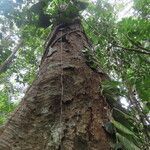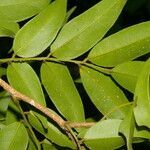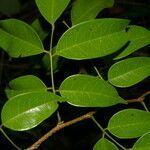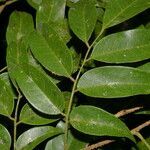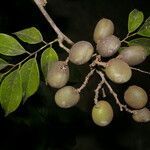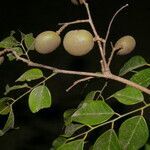Tall tree, with glabrous or puberulent branchlets. Leaves mostly 5-to 7-foliolate, caducous-stipulate, short-petiolate; rachis about 5-8 cm. long, often puberulent; leaflets ovate to elliptic-lanceolate, apically attenuate, basally rounded to cuneate, 3-12 cm. long, 1.5-4 cm. wide, glabrous, conspicuously reticulate, alternate or subopposite; petiolules about 3 mm. long, flattened or sulcate above, somewhat callous. Inflorescence an extended, branching panicle, terminal or sub-terminal, puberulent to glabrous; bracts caducous; pedicels very short. Flowers small, inconspicuous, apetalous; calyx pubescent without, densely so in bud, the receptacular portion short and stocky, the 5 lobes expanded, imbricate, obtuse, up to 3 mm. long; petals lacking; stamens 2, short; anthers bilocular, erect and basi-fixed, dehiscing by slits from the apex, the connective conspicuous; ovary sessile or subsessile, pubescent, 2-ovulate; style short, with a small terminal stigma. Legume subglobose to ellipsoid, up to 2.5 cm. long, very short-stipitate, with a fragile exocarp and somewhat fleshy endocarp.
More
A large tree. It grows 15-30 m high. The crown is a pyramid shape. It has large prop roots. The trunk is upright and 50-90 cm across. The bark is thin and scaly. The leaves are compound. There are 5-7 leaflets. The flowers are small and green. They are in groups at the ends of branches. The fruit is a fleshy pod. It has only one hard seed. The white aril or layer around the seeds is edible.
Dense, wet mixed forest at elevations up to 350 metres. Dense evergreen forests on well-drained clay soils, at the edge of virgin forests or in secondary formations on sandy soils.
More
A tropical plant. It grows in Brazil in the Amazon. It grows in rainforest and in mountain savanna forest on granite. In Central America it grows between 50-600 m altitude.
